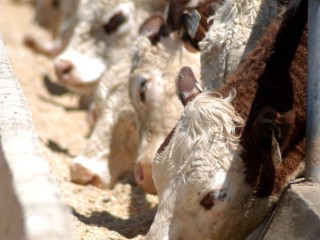 Numbers of cattle on grainfeeding programs across Australia declined by 10 percent or almost 79,000 head during the three months to September 30, the quarterly feedlot industry survey released yesterday shows.
Numbers of cattle on grainfeeding programs across Australia declined by 10 percent or almost 79,000 head during the three months to September 30, the quarterly feedlot industry survey released yesterday shows.
While some industry stakeholders were puzzled by the result, they said it might be explained by June figures that stayed higher than anticipated as cattle were still being washed out of the system. Similarly, the late September timing of the survey may have come too soon to catch the recent improvement in feedlot profitability.
The survey showed there was 713,728 head on feed at September 30, down 7pc on this time last year.
In Queensland, cattle numbers on feed were down 7pc to just below 408,000, while NSW was down 6.8pc to about 234,000. Victorian feedlots were down more than 25pc to 45,600 head, and SA feedlots dropped 10pc to 23,300 head.
Lotfeeding in WA reached its lowest point in 15 years, declining 86pc year-on-year to just 3151 head, down from 15,400 head in June. While the grainfed market continued to remain challenging in WA, local cattle producers have benefited from the much improved season in the west since mid-winter, constraining available cattle numbers.
That decline in numbers drove capacity utilisation rates in WA down to just 3pc of capacity, while nationally, the utilisation figure sits at 57pc.
Feeding capacity declines
Equally concerning was the decline in feedlot capacity evident in the survey, down more than 50,000 head nationwide by the end of September, and experienced in all states bar Victoria, where there was a scant rise of a few hundred head.
The national capacity to feed cattle fell from 1.305 million head in June to just over 1.25 million at the end of September.
Queensland was the worst hit, falling 30,000 head to 614,800 head. The declines were seen in all size categories in the State, with feedlots less that 500 head declining about 3000 head in capacity; lots 500-1000 head down 3000; lots 1000-10,000 head losing 4000 capacity; and lots above 10,000 head in size losing 20,000 head in capacity.
In southern states, NSW feedlot capacity (across all sizes) fell 9000 head to 409,400; while in South Australia, capacity was down about 2000 to 30,800.
In percentage terms, WA was the worst affected, where capacity was reduce by 12 percent, or 12,000 head during the past three months to September to 94,140 head.
AusMeat's Craig Firrell, officer in charge of the National Feedlot Accreditation Scheme, confirmed that there had been a ‘significant number’ of voluntary suspensions and cancellations of accreditations over the past six months, particularly among smaller lotfeeders.
The closures coincided with a period of poor feedlot profitability, as seen in Beef Central’s fortnightly breakeven calculations.
Australian Lot Feeders Association president Jim Cudmore said the survey outcome was the result of the confluence of the high Australian dollar, strong feeder cattle and grain prices along with continued global economic uncertainty.
“The Australian dollar for the quarter was up 16pc against the US$ year-on-year, feeder cattle up 6pc while feedgrain prices were at similar levels,” he said.
“Feeder cattle prices reflected the ongoing good seasonal conditions (and hence re-stocker demand for young cattle) while grain prices over the quarter remained strong due to mainly tight world corn stocks,” Mr Cudmore said.
Meat and Livestock Australia’s market information and analysis manager Tim McRae said grainfed exports to Australia’s major markets for the quarter were mixed, with a 19pc year-on-year decline to Japan and a 15pc rise in Korea.
“Total grainfed beef exports were 54,524 tonnes for the quarter, a fall of 8pc year-on-year, although 2pc higher than the previous quarter,” he said.
Total chilled grainfed shipments declined 9pc, to 33,476t, while frozen grainfed exports fell 5pc, to 21,048t.
With the fundamentals underlying the current economic uncertainty and dollar pressures unlikely to subside, lot feeders and exporters will be hopeful of further price improvements in the last quarter, Mr McRae said.
